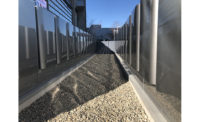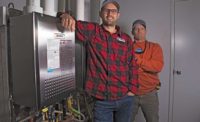The Mercedes-Benz Stadium in Atlanta is a $1.5 billion facility covering 2 million square feet. The stadium contains nearly 10 miles of heating, cooling, potable water, and stormwater piping. Construction on this piping system came with its share of challenges.
Tebarco Mechanical, a mechanical contracting partner of Atlanta Stadium Partners, was responsible for most of the pipe work in the facility. Tebarco’s scope of work included the chilled and hot water piping, which loops around the entire main level to feed the AHUs, as well as the domestic water piping that feeds the bathrooms and kitchens. Tebarco was also responsible for 13 risers, which carry water several hundred feet upward from the field to the stadium’s terminal units and air handlers.
The piping system network required more than 5,000 pipe joints. Design considerations for accommodating expansion and contraction of the structure had to be addressed because any movement resulting from extreme temperature conditions would impact the internal systems.
According to Martin Hartsfield, project manager at Tebarco Mechanical, meeting the tight two-year timeline for the build required the early involvement of contractors and partners.
“The penalties for late delivery were significant, so getting the project completed on time was a big deal,” said Hartsfield. “We needed to work with a company that had the products to simplify construction along with committed people who were willing to help find solutions when we ran into challenges.”
Victaulic’s Advanced Grooved System (AGS) flexible pipe couplings helped eliminate challenges with odd angles and connections required by the stadium’s architecture.
“We didn’t have to miter joints,” Hartsfield explained, “which would have been the case with welded connections.”
Instead, off-the-shelf AGS grooved elbows and AGS flexible couplings were used in what Hartsfield referred to as the “funky offsets” needed to make the piping go around the bends.
Victaulic’s AGS flexible pipe couplings were also used to address the movement requirements for the stadium, which was designed to allow for 4 inches of expansion. The flexible couplings are built to allow for pipe-end separation, leaving room for varying degrees of misalignment and controlled linear and angular movement. When movement forces are induced, the flexible pipe coupling remains a self-restrained joint, and the pressure-responsive gasket design provides positive sealing even during piping system movement.
Victaulic’s applications engineering team reviewed the drawings to determine the best way to contend with thermal movement, paying particular attention to the four corners of the structure where critical stresses and loads needed to be accommodated.
The team designed an expansion loop for each corner of the structure. This solution used the natural layout of the system, relying on flexible pipe couplings to allow for the required movement and to transfer the loads to the system’s anchors to achieve the necessary structural stability.
During weekly meetings, Tebarco assessed the type and quantity of components needed and provided Victaulic with its needs ahead of time. Relying on Victaulic allowed Tebarco to focus on execution rather than material sourcing. When dozens of 24-inch pipe headers were needed for the condenser water system, Victaulic manufactured the headers.
“We provided the drawings to Victaulic regarding where we needed taps and lengths of pipe, and they manufactured and delivered it,” Hartsfield said. “Everything fit like a glove.”
And to more efficiently handle the weight of the system and expedite installation, Tebarco fabricated a rack solution for the chilled, hot, and domestic water piping, which had to be installed 30 feet in the air.
“We laid three to four lengths of each piping system out together on racks, fit them together, and then came in with Victaulic couplings to join it all,” he said. “From there, the racks were put in place, and we moved around the whole stadium like that.”
The ability to visually inspect from the ground that the proper pipe couplings were installed correctly in the right locations throughout the stadium also allowed the builders to stay on schedule. The system required a mix of flexible and rigid pipe couplings installed in a strategic fashion to allow for proper expansion and contraction. Being able to see the difference in the pipe coupling types, especially from the ground, meant Tebarco could ensure the correct couplings were installed in the correct location.
The stadium’s retractable roof was outfitted with a 14- to 30-inch stormwater piping system to collect water and route it below ground to a cistern. Due to pipe size and weight, contractors did most of the piping fabrication on the ground. Workers were tasked with assembling the couplings and ensuring proper installation to eliminate rework when the trusses were put in place 400 feet above the stadium floor.
The complexity of the truss structures made it impossible to connect all the fittings on the ground, which meant some of the couplings had to be installed at height. Finding fitters trained to work 400 feet in the air proved to be difficult. Instead, professional climbers were trained to assemble the couplings after the trusses were installed.
After two years and thousands of connections, the Mercedes-Benz Stadium project was a success for Tebarco.
“All the piping systems tested out great,” concluded Hartsfield. “It was a successful project for our team for sure.”
For more on this project, see our cover story starting on page 24.




